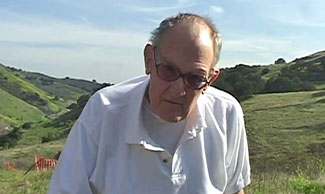A loss as big as all outdoors
October 17, 2013
Some people spend their lives trying to move mountains. Dave Brown was more ambitious: He devoted his life to ensuring that the mountains remain unchanged.
Brown, an historian, environmental activist and college professor who died Saturday at the age of 79 at his home in Calabasas, was remembered this week as a lifelong civic voice for the coastal trails, streams, hills and canyons in the wilderness area where he lived since 1966.
“His soul was devoted to the Central Santa Monica Mountains and the part of the Simi Hills that touches the Santa Monica Mountains,” said Paul Edelman, deputy director of natural resources and planning at the Santa Monica Mountains Conservancy, where Brown had served as a member of the advisory board since the mid-1980s.
“He was just this guardian and watchdog who would go to incredible lengths to make sure they were protected, and who cared about every major piece.”
Brown, who was born in Illinois and moved to California as a graduate student in the late 1950s, taught history and political science for more than 40 years at Los Angeles Valley College in Van Nuys, but was also known locally for his passionate efforts, starting in the 1970s and early 1980s, to halt development in the pristine mountains.
Working determinedly within the local environmental movement, Brown contributed to the preservation of tens of thousands of acres. He was one of a number of local influencers who helped stop the development of King Gillette Ranch, which had been slated to become part of a Soka University expansion; now the ranch hosts the Visitor’s Center of the Santa Monica Mountains National Recreation Area. His advocacy also helped save or create such important wilderness landmarks as Malibu Creek State Park, the Zev Yaroslavsky Las Virgenes Highlands Park and the Backbone Trail.
Over time, he became sought after as an informed and pragmatic voice on local land use issues, and he served on the city of Calabasas’ Planning Commission for several decades, winning national recognition for his civic contributions. He also devoted countless hours to the Sierra Club, the Audubon Society, the Malibu Creek State Park Docents and other environmental organizations. (To catch a moment of a Brown-led tour of the park several years ago, click here.)
“He was an incredible, encyclopedic resource,” said Kim Lamorie, who knew him as a 35-year member of the Las Virgenes Homeowners Federation, of which Lamorie is president.
“He knew all the properties, he knew all the trees, he knew every ridgeline. And he was a master mapper. He had more maps than anyone I’ve ever known.”
“He was a big man with a big hat and a big voice, and he spoke with a lot of authority,” said John Suwara, a friend and neighbor of nearly four decades. “Dave was a realist, but he fought tooth and nail, right up to the end.
“Even as recently as March, he was going to Planning Commission meetings and reviewing documents. That was maybe the biggest thing about him—he did it day after day, year after year, decade after decade. He wasn’t one of these people who are there one day and gone the next.”
In fact, Edelman said, because of Brown’s longevity and commitment, there are now spots in the Santa Monica Mountains in which every visible piece of the wilderness, all the way to the horizon, is arguably there, at least in part, because of him.
“There’s one overlook on Piuma Road,” he said, “where everything you see is something he had an absolute hand in, from the valley bottom to the ridge lines.”
And then there is the matter of how the mountains shaped Brown’s life and outlook.
Last year, after the majestic, 200-acre Firehouse Hill—now the Zev Yaroslavsky Las Virgenes Highlands Park—was saved from development in Calabasas, Brown, by then in frail health, stood among its oaks and considered what the place meant to him.
“I sometimes sort of tell myself that if the Lord should see fit to send me upstairs instead of downstairs,” he said, “I would expect that I would walk up to heaven through a place like this.”
Posted 10/17/13














 405 bridge work causes a stink
405 bridge work causes a stink
